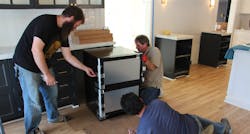Tight Fit: The Challenges of Installing Integrated Appliances
I work in the Dallas area, and about six years ago, Texas began requiring appliance installers to get licensed. A lot of people hated that and flunked the test, but personally, I was glad that they finally did something to create a level of accountability.
The test is open book, but it isn’t necessarily easy. You could look at the National Electrical Code while taking the test, but that book is, like, 3 inches thick, so if you just went in and tried to find all the answers there, you’d be out of luck.
There’s a good reason for the license. In the past, builders and remodelers would bring in unskilled guys to put in appliances, and they had problems. Now, there’s the trend for integrated appliances and flush cabinets, and that makes it more complicated. The cabinet guys aren’t always used to it and don’t know the little extra things you have to do when you want the appliances to end up flush.
For instance, with an integrated appliance, you only want a ⅛-inch reveal around the panels. So if the opening for the refrigerator isn’t level and plumb, you won’t end up with that ⅛-inch reveal. Or, say the cabinet is ¼ inch wider at the bottom. That’s not much based on the old standards, but it will really show with an integrated panel.
Appliances all have four feet, and you have to level them. But a lot of the time, the cabinets themselves aren’t perfectly level. So, in many cases, the choice is a level appliance that sits under a slanting countertop, or an out-of-level appliance that follows the cabinetry. It’s usually a cosmetic thing, so the way you handle it is ultimately up to the homeowner.
Another issue I often run into is when the appliance actually doesn’t fit. If you have a 36-inch refrigerator that needs to go into a 38-inch opening, it’s no big deal. But if you have a 36-inch built-in refrigerator that has to fit in a 35 ⅞-inch opening, that’s another thing altogether. The effect is supposed to be an unbroken wall of cabinetry, but now you have just a little bit of a lip. It’s an exact science.
We see other problems, too, that aren’t really related to cabinetry. For instance, much of the time, the electrical outlet is placed in the wrong spot on the wall. If the appliance is a KitchenAid, there’s more room, but Wolf and Viking ranges won’t sit flush unless the outlet is in exactly the right place. Sometimes we’ll move the outlets ourselves, but if the electrician is still on site, we’ll ask him to do it.
I’ve also ended up coming in behind another installer and discovered that they’ve done something odd. For example, they may have forgotten to put in a shut-off valve for the water supply to a built-in refrigerator, which means that to turn the water off you have to uninstall the whole thing. Believe me, I’ve seen it all.
---
James Gall is president of DFW Workskills, in Dallas.
Watch videos and find out more about the model remodel at modelremodel2015.com.
